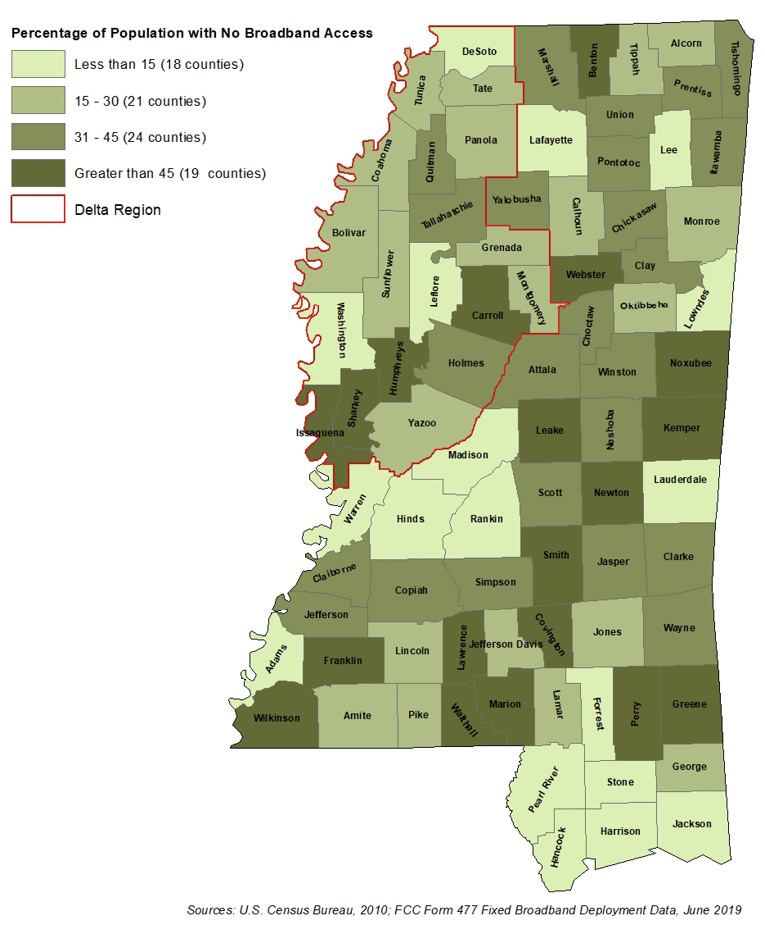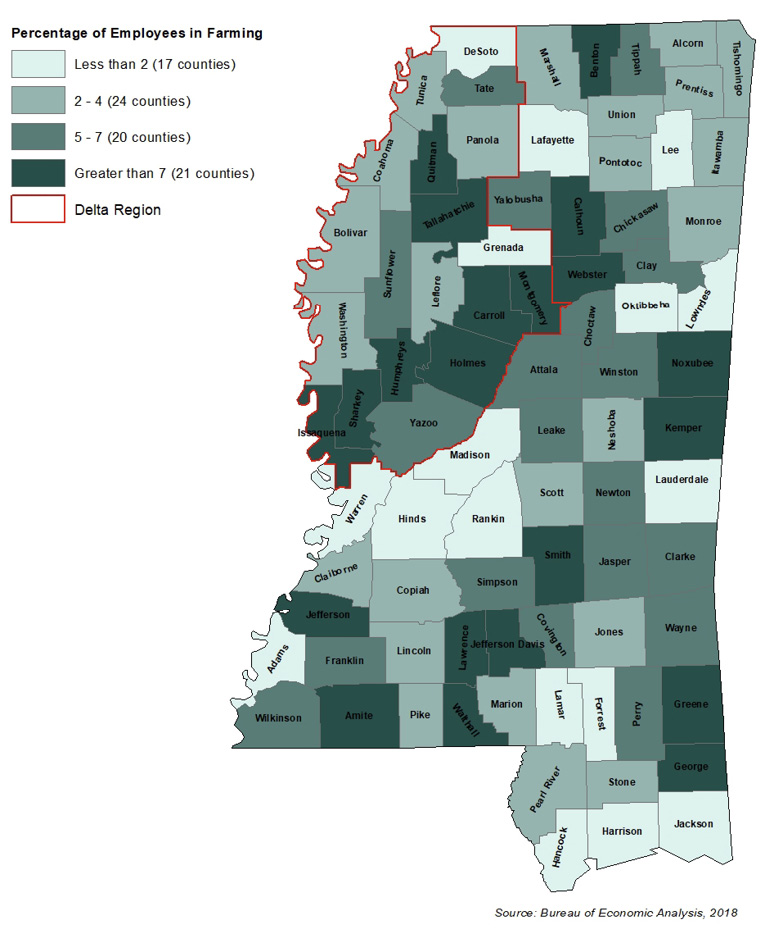Mississippi Agriculture Lacks Broadband Access
For employees in any industry, having reliable internet access improves networking, innovation, and overall output. In the farming industry, the internet allows farmers to have up-to-date information on prices and policies that impact their marketing decisions. Agriculture is becoming increasingly technology-intensive with the introduction of precision farming techniques. Having reliable broadband internet allows farmers to adopt and readily use these technologies to improve their productivity and, ultimately, their profits.
Broadband internet is considered anything at or above a 25 megabits per second (Mbps) download speed and a 3 Mbps upload speed. The most recent Federal Communications Commission data from June 2019 indicates that, in Mississippi, about 19 percent of the population does not have access to broadband (FCC, 2020). However, there is a considerable difference in broadband access between urban and rural areas.
Only around 9 percent of residents in urban counties do not have broadband access. In comparison, about 27 percent of residents in rural counties do not have broadband available to them (U.S. Census Bureau, 2010; USDA, 2019; FCC, 2020). Since rural counties are more likely to have high farm employment, there is a high potential that Mississippi producers are negatively impacted by their lack of broadband access.
Broadband and Farm Employment
Figure 1 shows the percentage of residents with no broadband internet access. As expected, a high percentage of residents in the Jackson metropolitan area have internet access, as do residents near Biloxi on the coast. In 19 counties, more than 45 percent of the population does not have access to broadband internet. In the south-central and Delta regions of Mississippi, high percentages of residents do not have broadband.

Figure 2 shows the percentage of residents who are employed in farming. Across the state, about 2 percent of employment is in farming, but in 21 counties, more than 7 percent of county employment is in farming. As in Figure 1, the Delta region stands out. Many of the counties in the Delta are highly dependent on farm employment. These producers are at a significant disadvantage because of their limited access to broadband. The southern portion of Mississippi also has counties with high farming-employment percentages and a significant lack of broadband access.

The maps in Figures 1 and 2 show that areas with high farm employment have low broadband access. This relationship is further examined in Figure 3. A trendline shows a positive association between the percentage of population without broadband access and the percentage of employment in farming. In other words, counties in Mississippi that lack broadband access also tend to have a large farming workforce. Figure 3 also differentiates counties that are rural versus urban. Most of the counties in Mississippi are considered rural, with only 17 counties classified as urban.

Mississippi Delta Region
Because the Delta region has both low broadband availability and high farm employment, we examined how this region differs from the rest of the state. The Delta region is outlined in red in Figures 1 and 2 and is comprised of 19 counties. In this region, 18 percent of residents do not have access to broadband, which is slightly lower than the state average (19 percent). However, the disparity between urban and rural broadband access is noteworthy. Only 9 percent of residents in urban counties in the Delta do not have access to broadband, compared to 24 percent of rural residents. With around 58 percent of the population in the Delta living in rural counties, rural residents are significantly underserved in terms of broadband access.
Around 4 percent of total employment in the Delta is in farming, about 2 percent higher than the state average. Many counties in the Delta are highly dependent on farming. Issaquena, Quitman, and Carroll Counties have the three highest farming employment percentages at 37, 19, and 16 percent, respectively. DeSoto County has the lowest percentage of employment in farming at only 1 percent (BEA, 2018).
Figure 4 shows the strong relationship between the percentage of farm employment and lack of access to broadband in the Delta region. This association is stronger in the Delta than in the entire state. A good example of this relationship is Issaquena County, which has both the highest percentage of its population without broadband access (96 percent) and the highest farm employment percentage (37 percent) of all 82 counties in Mississippi.

Conclusion
The majority (58 percent) of Mississippi’s almost 3 million residents live in rural counties. However, rural residents account for 80 percent of the population without broadband access (U.S. Census Bureau, 2010; FCC, 2020). Therefore, residents in rural counties are underserved with broadband access compared to those in urban counties. With farm production primarily found in rural areas, this is a significant limitation to agricultural production in the state. Mississippi counties with a high percentage of their workforce in farming also tend to have lower broadband availability. This relationship is stronger in the Delta region.
Lack of access to broadband could put Mississippi producers at a significant disadvantage compared to other states. Not having reliable internet limits farmers’ access to policies and marketing information to use in management decisions. It also decreases their ability to use new precision technologies that could increase productivity and profitability. Future broadband-related policies and programs should focus on bringing reliable internet access to rural communities in Mississippi to support agriculture and other industries in those areas.
References
Bureau of Economic Analysis. 2018. Total Full-Time and Part-Time Employment by Industry.
Federal Communications Commission. 2020. Fixed Broadband Deployment Data from FCC Form 477.
United States Census Bureau. 2010. Total Population, Decennial Census.
United States Department of Agriculture Economic Research Service. 2019. Rural-Urban Continuum Codes.
Publication 3534 (POD-01-24)
By Devon Mills, PhD, Assistant Professor, Agricultural Economics, and Brian Mills, PhD, Assistant Professor, Delta Research and Extension Center.
The Mississippi State University Extension Service is working to ensure all web content is accessible to all users. If you need assistance accessing any of our content, please email the webteam or call 662-325-2262.










